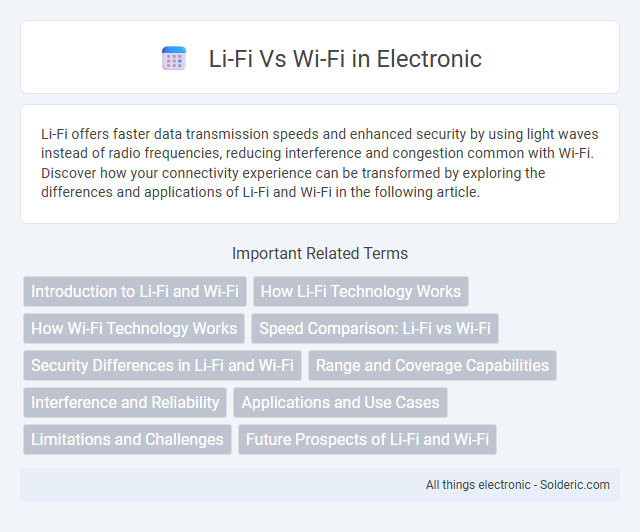Li-Fi offers faster data transmission speeds and enhanced security by using light waves instead of radio frequencies, reducing interference and congestion common with Wi-Fi. Discover how your connectivity experience can be transformed by exploring the differences and applications of Li-Fi and Wi-Fi in the following article.
Comparison Table
| Feature | Li-Fi (Light Fidelity) | Wi-Fi (Wireless Fidelity) |
|---|---|---|
| Technology | Visible Light Communication (VLC) | Radio Frequency (RF) Communication |
| Frequency Spectrum | Visible Light Spectrum (400-700 nm) | 2.4 GHz and 5 GHz Bands |
| Data Transmission Speed | Up to 10 Gbps | Up to 3.5 Gbps (Wi-Fi 6) |
| Range | Short--Typically a few meters | Medium--Up to 100 meters indoors |
| Interference | Low, no radio interference | High, susceptible to RF interference |
| Security | More secure, light cannot penetrate walls | Less secure, RF signals pass through walls |
| Applications | High-speed indoor communication, secure environments | General wireless networking, internet access |
| Power Consumption | Low, uses LED light sources | Moderate to high |
| Cost | Emerging technology, higher initial cost | Mature technology, widely affordable |
Introduction to Li-Fi and Wi-Fi
Li-Fi (Light Fidelity) uses visible light communication to transmit data, offering high-speed and secure wireless connectivity through LED light sources. Wi-Fi relies on radio frequency waves to provide widespread wireless internet access commonly used in homes and public spaces. Your choice between Li-Fi and Wi-Fi depends on factors like environment, speed requirements, and interference tolerance.
How Li-Fi Technology Works
Li-Fi technology transmits data using visible light communication (VLC) by modulating LED light bulbs at extremely high speeds imperceptible to the human eye. This modulation converts the light signals into electrical signals that a photodetector receives and decodes back into data. Unlike Wi-Fi, which uses radio waves, Li-Fi offers significantly higher data transmission speeds and enhanced security due to line-of-sight requirements.
How Wi-Fi Technology Works
Wi-Fi technology transmits data wirelessly using radio frequency waves, typically operating in the 2.4 GHz and 5 GHz bands, enabling devices to connect to the internet or local networks without physical cables. Routers convert digital data into radio signals and broadcast them, while Wi-Fi-enabled devices receive and decode these signals to establish communication. This method provides widespread coverage and mobility but can be susceptible to interference from physical obstacles or other electronic devices operating on similar frequencies.
Speed Comparison: Li-Fi vs Wi-Fi
Li-Fi delivers data transmission speeds up to 224 Gbps using visible light communication, significantly surpassing Wi-Fi's maximum standard speeds of around 9.6 Gbps under the latest Wi-Fi 6E protocol. The use of light waves in Li-Fi provides a broader spectrum and less signal interference, enabling faster and more secure data transfer in dense environments. Wi-Fi's reliance on radio frequencies limits its throughput and exposure to electromagnetic interference, making Li-Fi a superior choice for ultra-high-speed wireless communication.
Security Differences in Li-Fi and Wi-Fi
Li-Fi offers enhanced security compared to Wi-Fi due to its use of visible light for data transmission, which cannot penetrate walls, limiting signal access to physical spaces. Wi-Fi signals can extend beyond physical boundaries, making them more vulnerable to unauthorized access or hacking attempts. Your network security benefits from Li-Fi's confined signal range, reducing risks of external cyber threats common in traditional Wi-Fi setups.
Range and Coverage Capabilities
Li-Fi technology offers limited range and coverage, typically effective within a single room due to its reliance on visible light that cannot penetrate walls. Wi-Fi provides broader coverage, capable of extending across multiple rooms or floors through radio frequency signals that pass through obstacles. While Wi-Fi is more versatile for large areas, Li-Fi delivers high-speed connectivity in confined spaces with minimal interference.
Interference and Reliability
Li-Fi offers higher reliability than Wi-Fi by using light waves, which are less prone to electromagnetic interference commonly affecting radio-frequency Wi-Fi signals. You experience consistently stable connections with Li-Fi in environments crowded with electronic devices, where Wi-Fi signals often suffer from congestion and signal degradation. This makes Li-Fi ideal for interference-sensitive applications requiring dependable and interference-free wireless communication.
Applications and Use Cases
Li-Fi technology excels in environments requiring high-speed, secure data transmission, such as hospitals, aircraft cabins, and industrial automation where radio frequency interference must be minimized. Wi-Fi remains dominant for general internet access in homes, offices, and public hotspots due to its extensive range and device compatibility. Your choice between Li-Fi and Wi-Fi depends on specific application needs, including security levels, speed requirements, and environmental constraints.
Limitations and Challenges
Li-Fi faces limitations such as limited range and the inability to penetrate walls, restricting its usability to line-of-sight environments, while Wi-Fi offers broader coverage but can suffer from signal interference and congestion in crowded areas. Li-Fi's reliance on LED light sources means it cannot operate in the dark, posing challenges for continuous connectivity, whereas Wi-Fi's radio frequency signals provide more consistent indoor and outdoor performance. Understanding these challenges helps you choose the right technology for specific applications where speed, security, and coverage are critical.
Future Prospects of Li-Fi and Wi-Fi
Li-Fi technology offers promising future prospects with ultra-fast data transmission speeds exceeding 100 Gbps, enhanced security due to light-based communication, and reduced electromagnetic interference, making it ideal for dense urban environments and IoT applications. Wi-Fi continues to evolve with Wi-Fi 6E and the upcoming Wi-Fi 7 standards, providing wider bandwidth, lower latency, and better support for a massive number of connected devices in smart homes and enterprises. The complementary integration of Li-Fi and Wi-Fi is expected to create hybrid networks that leverage the strengths of both technologies, paving the way for seamless, high-capacity wireless communication in 5G and beyond ecosystems.
Li-Fi vs Wi-Fi Infographic

 solderic.com
solderic.com